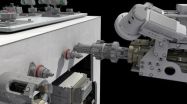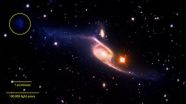(Press-News.org) New Rochelle, NY, January 10, 2013—Stem cells can be grown on biocompatible scaffolds to form complex tissues such as bone, cartilage, and muscle for repair and regeneration of damaged or diseased tissue. However, to function properly, the cells must often grow in a specific pattern or alignment. An innovative method for creating a stretched polymer scaffold that can support complex tissue architectures is described in an article in Tissue Engineering, Part C, Methods, a peer-reviewed journal from Mary Ann Liebert, Inc., publishers. The article is available on the Tissue Engineering, Part C, Methods website.
Zu-yong Wang and a team of researchers from National University of Singapore, Nanyang Technological University, KK Women's and Children's Hospital, and Duke-NUS Graduate Medical School, in Singapore, developed a reproducible method that involves stretching a polymer thin film to produce scaffolds that can support the growth of human mesenchymal stem cells. The stretching process creates orientated 3-dimensional micro-grooves on the surface of the films, and these formations promote consistent alignment and elongation of stem cells as they grow and develop into tissues on and around the resorbable scaffold.
The authors present their work in the article, "Biomimetic 3D anisotropic geometries by uniaxial stretch of poly(?-caprolactone) films for mesenchymal stem cell proliferation, alignment and myogenic differentiation."
"The researchers developed a very elegant method to promote cell behavior," says John Jansen, DDS, PhD, Methods Co-Editor-in-Chief and Professor and Chairman, Department of Biomaterials, Radboud University Nijmegen Medical Center, The Netherlands.
INFORMATION:
About the Journal
Tissue Engineering is an authoritative peer-reviewed journal published monthly in print and online in three parts: Part A--the flagship journal; Part B—Reviews; and Part C—Methods. Led by Co-Editors-In-Chief Antonios Mikos, PhD, Louis Calder Professor at Rice University, Houston, TX, and Peter C. Johnson, MD, Vice President, Research and Development, Avery Dennison Medical Solutions of Chicago, IL and President and CEO, Scintellix, LLC, Raleigh, NC, the Journal brings together scientific and medical experts in the fields of biomedical engineering, material science, molecular and cellular biology, and genetic engineering. Tissue Engineering is the Official Journal of the Tissue Engineering & Regenerative Medicine International Society (TERMIS). Complete tables of content and a sample issue may be viewed on the Tissue Engineering website.
About the Publisher
Mary Ann Liebert, Inc., publishers is a privately held, fully integrated media company known for establishing authoritative peer-reviewed journals in many promising areas of science and biomedical research, including Stem Cells and Development, Human Gene Therapy, and Advances in Wound Care. Its biotechnology trade magazine, Genetic Engineering & Biotechnology News (GEN), was the first in its field and is today the industry's most widely read publication worldwide. A complete list of the firm's 70 journals, books, and newsmagazines is available on the Mary Ann Liebert, Inc., publishers website.
Mary Ann Liebert, Inc. 140 Huguenot St., New Rochelle, NY 10801-5215 www.liebertpub.com
Phone: (914) 740-2100 (800) M-LIEBERT Fax: (914) 740-2101
3-D biomimetic scaffolds support regeneration of complex tissues from stem cells
2013-01-11
ELSE PRESS RELEASES FROM THIS DATE:
NASA sees Tropical Cyclone Narelle approaching Western Australia coast
2013-01-11
NASA's Aqua satellite looked at Cyclone Narelle in visible and infrared light to understand the behavior of the storm. NASA's MODIS and AIRS instruments provided those data, respectively, and they showed that Narelle is gaining strength as it approaches the northern coast of Western Australia.
Watches and Warnings are posted for the western coast of Western Australia over the next several days as Narelle continues to move on a southerly track, where it is expected to remain at sea, but parallel the coast.
Current Australian warnings include: a Cyclone Warning is in ...
Surgical technique spots cancer invasion with fluorescence
2013-01-11
One of the greatest challenges faced by cancer surgeons is to know exactly which tissue to remove, or not, while the patient is under anesthesia. A team of surgeons and scientists at University of California, San Diego School of Medicine have developed a new technique that will allow surgeons to identify during surgery which lymph nodes are cancerous so that healthy tissue can be saved. The findings will be published in the January 15 print edition of Cancer Research.
"This research is significant because it shows real-time intraoperative detection of cancer metastases ...
Scripps Florida scientists uncover potential drug target to block cell death in Parkinson's disease
2013-01-11
JUPITER, FL, January 10, 2013 – Oxidative stress is a primary villain in a host of diseases that range from cancer and heart failure to Alzheimer's disease, Amyotrophic Lateral Sclerosis and Parkinson's disease. Now, scientists from the Florida campus of The Scripps Research Institute (TSRI) have found that blocking the interaction of a critical enzyme may counteract the destruction of neurons associated with these neurodegenerative diseases, suggesting a potential new target for drug development.
These findings appear in the January 11, 2013 edition of The Journal of ...
NASA's robotic refueling demo set to jumpstart expanded capabilities in space
2013-01-11
In mid-January, NASA will take the next step in advancing robotic satellite-servicing technologies as it tests the Robotic Refueling Mission, or RRM aboard the International Space Station. The investigation may one day substantially impact the many satellites that deliver products Americans rely upon daily, such as weather reports, cell phones and television news.
During five days of operations, controllers from NASA and the Canadian Space Agency will use the space station's remotely operated Special Purpose Dexterous Manipulator, or Dextre, robot to simulate robotic ...
Study finds poorer outcomes for obese patients treated for lumbar disc herniation
2013-01-11
Rosemont, Ill. – While obese patients are more likely to have surgical treatment for lumbar disc herniation – a slipped or ruptured disc – than nonobese patients, obesity increases operative time, blood loss and length of hospital stay, according to new research published in the January 2013 Journal of Bone and Joint Surgery (JBJS). Overall, obese patients had poorer outcomes with surgical and nonsurgical treatments for lumbar disc herniation than nonobese patients.
The study included 854 nonobese patients with a Body Mass Index (BMI) of less than 30 kg/m², and 336 ...
Virus caught in the act of infecting a cell
2013-01-11
AUSTIN, Texas — The detailed changes in the structure of a virus as it infects an E. coli bacterium have been observed for the first time, report researchers from The University of Texas at Austin and The University of Texas Health Science Center at Houston (UT Health) Medical School this week in Science Express.
To infect a cell, a virus must be able to first find a suitable cell and then eject its genetic material into its host. This robot-like process has been observed in a virus called T7 and visualized by Ian Molineux, professor of biology at The University of Texas ...
Stem cells found to heal damaged artery in lab study
2013-01-11
Scientists at the Texas Biomedical Research Institute have for the first time demonstrated that baboon embryonic stem cells can be programmed to completely restore a severely damaged artery. These early results show promise for eventually developing stem cell therapies to restore human tissues or organs damaged by age or disease.
"We first cultured the stem cells in petri dishes under special conditions to make them differentiate into cells that are the precursors of blood vessels, and we saw that we could get them to form tubular and branching structures, similar to ...
UC Davis study deflates notion that pear-shaped bodies more healthy than apples
2013-01-11
(SACRAMENTO, Calif.) — People who are "apple-shaped" — with fat more concentrated around the abdomen — have long been considered more at risk for conditions such as heart disease and diabetes than those who are "pear-shaped" and carry weight more in the buttocks, hips and thighs.
But new research conducted at UC Davis Health System published in The Journal of Clinical Endocrinology and Metabolism provides further evidence that the protective benefits of having a pear-body shape may be more myth than reality. The journal article posted online January 10 and will appear ...
Oxygen to the core
2013-01-11
LIVERMORE, Calif. -- An international collaboration including researchers from Lawrence Livermore National Laboratory has discovered that the Earth's core formed under more oxidizing condition's than previously proposed.
Through of series of laser-heated diamond anvil cell experiments at high pressure (350,000 to 700,000 atmospheres of pressure) and temperatures (5,120 to 7,460 degrees Fahrenheit), the team demonstrated that the depletion of siderophile (also known as "iron loving") elements can be produced by core formation under more oxidizing conditions than earlier ...
NASA's GALEX reveals the largest-known spiral galaxy
2013-01-11
The spectacular barred spiral galaxy NGC 6872 has ranked among the biggest stellar systems for decades. Now a team of astronomers from the United States, Chile and Brazil has crowned it the largest-known spiral, based on archival data from NASA's Galaxy Evolution Explorer (GALEX) mission, which has since been loaned to the California Institute of Technology, Pasadena
Measuring tip-to-tip across its two outsized spiral arms, NGC 6872 spans more than 522,000 light-years, making it more than five times the size of our Milky Way galaxy.
"Without GALEX's ability to detect ...






